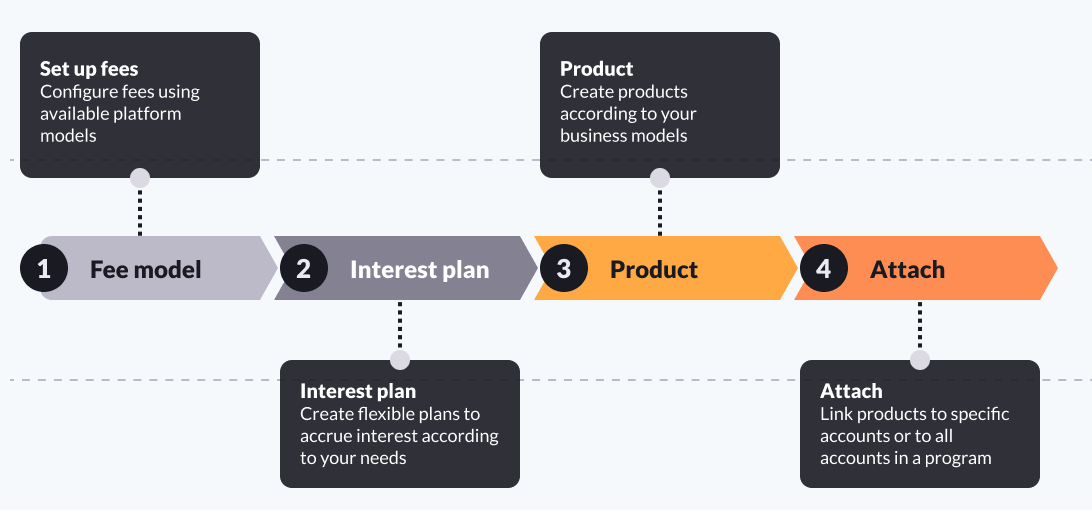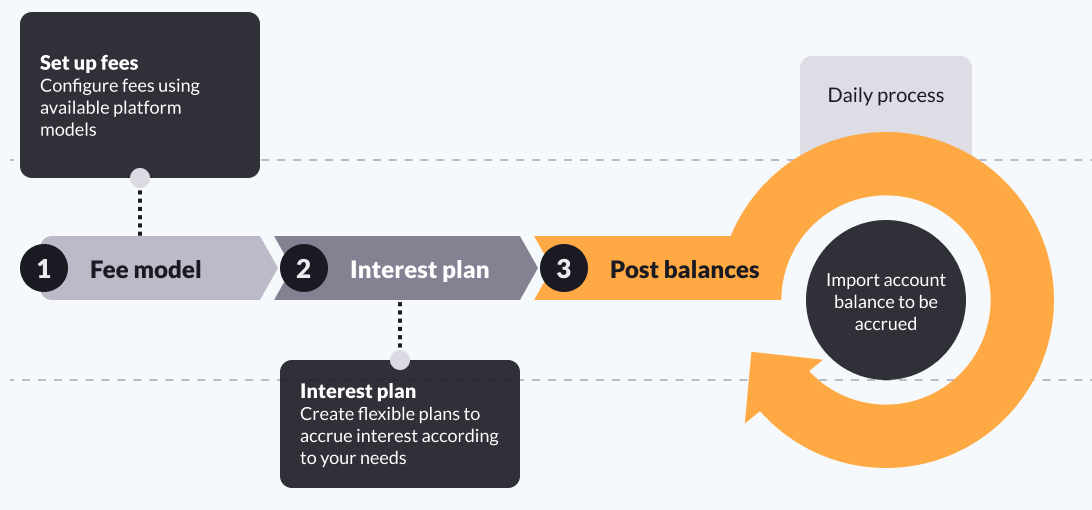Interest-bearing accounts
Banks and financial institutions offer various types of accounts that can earn interest, including savings accounts, and deposit accounts. These accounts are typically used for short-term savings, emergency funds, specific goals like travel or major purchases, or as part of a diversified investment strategy. They provide a safer alternative to riskier investment options and offer a convenient solution for saving money while accruing interest. These accounts can often be created as sub-accounts by account holders through their banking apps.
The Pismo platform offers an API that supports a wide range of interest-bearing accounts, including savings and deposit accounts, all capable of performing daily interest calculations and payouts as well as on a monthly, quarterly, semi-annual, annual basis, or at its maturity.
Pismo offers the following bank account products, each with its own specific rules and benefits:
-
Savings account or interest-bearing account: These accounts can be created as sub-accounts in banking apps, allowing for easy deposit and withdrawal of funds.
-
Deposit accounts: Also known as Certificates of Deposit (CDs), these accounts have a preset maturity date. Customers must leave their money in the account for an agreed-upon term. Early withdrawals may incur fees, and these accounts often have a minimum deposit requirement, a maximum balance limit, and a cooling-off period. They offer various rule possibilities, making them versatile for clients looking for different interest calculation options.
The return, interest rate, and other features of these accounts depend on the account terms and conditions and can vary based on the account type and the financial institution. They might require a minimum deposit or balance, have restrictions on withdrawals and transfers, and the terms can change over time.
Deposit accounts are particularly popular on the Pismo platform due to their ability to support multiple rule possibilities, while savings accounts remain more basic. The interest-bearing accounts solution from Pismo is notable for its robust capability to process large volumes of daily operations, fully customizable fee and interest calculations, and the generation of legal reports.
This guide provides information on the available options to set up interest-bearing accounts on the Pismo platform, including common parameters, outputs, and examples.
Interest-bearing accounts on the Pismo platform
Core banking by Pismo
If you maintain accounts in the Pismo platform as part of its core banking solution, you have seamless access to the products and solutions offered by Pismo and are uniquely set up to take advantage of their flexible configurations and high-capacity processing.
In this case, work with the Pismo representative to set up interest-bearing accounts. Note that you can also set up the following steps in Pismo Control Center:
- If applicable, set up the fee model in the Pismo platform to withhold any taxes or operational fees. Refer to Fee models for how to set this up in Control Center.
- Configure a flexible plan to accrue interest according to your needs. To set this up in Control Center, refer to Interest plans.
- Create a product (Savings or Deposit product) in the Pismo platform. Refer to Deposit products if you want to configure it using Control Center.
- Attach the product you created to specific accounts or all accounts in a program.

Minimum amount for interest calculation
- You have the option to specify a minimum amount used for interest calculation—either at the program level or for a specific account ID. If you choose not to set a minimum, interest is calculated on any amount. To add or change this minimum, call Update parameter (account level), or Update program parameter (program level).
- To get the minimum amount you have already set:
- For a specific account, call List parameters and look for the value in
MIN SAVINGS APPLICATION.- Likewise, for a program-wide minimum, call List program parameters and look for the field
MIN SAVINGS APPLICATION.
Pismo integration with other core banking systems
If you maintain accounts in a different core banking system outside of Pismo, you can still utilize the Pismo platform to offer interest-bearing accounts to your clients and to process daily accrual calculations. In addition to the flexibility and high capacity of Pismo platform processing, this solution offers legal reports.
In this case, work with the Pismo representative to set up interest-bearing accounts.
- If applicable, set up the fee model in the Pismo platform to withhold any taxes or operational fees.
- Configure a flexible plan to accrue interest according to your needs.
- Configure integration with your core banking system.

Common configuration parameters
The following parameters are common for setting up interest-bearing accounts.
| Parameter | Possible values |
|---|---|
| Accrual basis dictates the total days in a year to be considered when calculating the daily rate. | * BD/252 - calculates daily interest using a 252-day year and the actual number of business days in each time period. * Actual/360 - calculates daily interest using a 360-day year and the actual number of days in each time period. * Actual/365 - calculates daily interest using a 365-day year and the actual number of days in each time period. * Actual/actual - calculates daily interest using the actual number of days in the year (which in the leap year is 366) and the actual number of days in each time period. |
| Accrual frequency defines when the accrual process happens. | * Daily * Monthly * * Quarterly * * Semi-annually * * Yearly * * Maturity* |
| Capitalization frequency defines when the interest payment happens. | * Daily * Monthly * * Quarterly * * Semi-annually * * Yearly * * Maturity* |
| Interest type indicates if the accrual is based on simple or compound interest calculation. | * Simple - calculated only on the initial principal deposit amount. * Compound - calculated on both the initial principal and all of the previously accumulated interest, thereby multiplying savings at an accelerated rate. |
| Interest rates determine how much interest the account holder earns on their deposits. | * Fixed - remains constant for a specific period. * Benchmark rate - can fluctuate over time in response to market conditions. For instance, reference rates like those in the US, or benchmark rates such as DI in Brazil, BOE in the UK, RBI in India, or RBA in Australia. * Margin rate is a percentage applied on the benchmark rate. For example, if the DI rate is 10.65%, the financial institution can provide an interest-bearing account that pays 100% of this rate for a year (the same 10.65%) or 103% of this rate (10.96%). * Margin / Spread is a percentage added to the benchmark rate. For example, if the BOE rate today is 2.5% and spread is 2.25%, so the interest rate used to calculate is 4.75. |
| Fee is any fee or tax that you want to apply. | You can configure and attach any fee model. For example, you can configure and apply national taxes or custom operational fees. |
Output events
The Pismo platform generates events such as Interest accrual succeeded and Interest capitalization succeeded.
Regulatory reports
Contact your Pismo representative for the regulatory reports available in your region.
Examples
Scenario 1
In the first scenario, the principal amount is $10000, floating interest rate is DI (where DI is 10.65% for the whole period), index rate is 103%, accrual rate is daily, and payout frequency is daily. The platform uses the account balance to calculate and generate the yield daily after the cut-off window and credits it to the account the next business day (D+1) based on the configurations. For example, if the account holder doesn't make any deposits or withdrawals, the account accrues the following amounts.
- On day 2, the credited amount is 4.13.
- On day 3, the credited amount is 4.13.
- On day 4, the credited amount is 4.14, and so on.
Scenario 2
In the second scenario, the principal amount is $10000, fixed interest rate is 6.17%, accrual rate is monthly, and payout frequency is monthly. The platform uses the account balance to calculate and generate the yield monthly and credits it to the account monthly. For example, if the account holder doesn't make any deposits or withdrawals, the account accrues the following amounts.
- For month 2, the credited amount is 50.02.
- For month 3, the credited amount is 50.27.
- For month 4, the credited amount is 50.51, and so on.
Updated 9 days ago